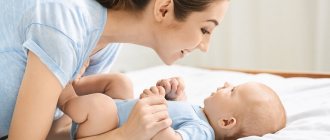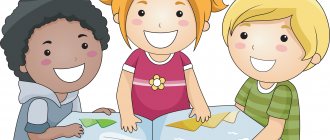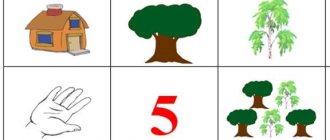Creative imagination is the “engine” that launches the creation of a completely new work or image. Thanks to this mental process, people received masterpieces of art, great inventions and discoveries. And no matter how significant the result, the origins of achievements should be sought in childhood, when the potential of the cognitive sphere begins to form. Therefore, it is important to know how the development of creative imagination occurs in preschoolers, and how to develop personality in this direction.
Brief description of the process
Psychologists insist that creative imagination is special. This is an active learning process.
The imagination can work even in a dream, giving rise to stories, one more incredible than the other. But in this case the nature of the process is passive. Imagination can also be reconstructive, helping to imagine an already familiar object, phenomenon or event. The named types have little to do with creativity. Creative imagination is characterized by novelty and originality of the result. Known schemes and ready-made descriptions are used partially or not at all.
Distinctive features of a child's creative imagination
The imagination of a preschooler, like all cognitive processes at this age, most often acts involuntarily. It is still inappropriate to talk about special plans and goals characteristic of the boundless flight of thought. But active imagination and the desire to try out many things from one’s own experience indicate the beginning of the development of creative imagination in preschool children. Signs of creativity are clearly visible.
- Brightness and originality of fantasies and images
Children create incredible stories in which they give toys or ordinary objects “magical” properties. This happens because preschoolers are immersed in the world of fairy tales and cartoons. They may imagine themselves as characters from a fairy tale and be creative in describing the character's strengths or frightening traits. In addition, the child’s experience is not sufficient to understand the phenomena of the world around him, and he himself comes up with explanations for them.
- Active use of well-known images in new conditions
Developing creative abilities, the child repeats himself less and less often and more often practices creating new images, placing fictional characters in different situations. For example, an older preschooler is able to compose several stories about a fairy-tale hero. The image of the hero is the result of the work of creative imagination, and numerous stories with his participation appear due to the growth in the content of the child’s creativity.
The imaginary plot is embodied in the drawing
The fact that a child’s idea of something often goes beyond the usual boundaries also speaks about creative imagination. So, when completing the task of drawing rain in a fairyland, children imagine it as a shooting star, candy or flower rain.
When a preschooler is receptive to the development of creative imagination
In psychology, the stages of development of the creative imagination of preschoolers are conventionally distinguished.
The initial stage appears when children, already knowing the real purpose of an object, use it in a new capacity. A replacement appears, but only an object that is somewhat similar (shape, color...) is assigned to the role of “substitute”. For example, imitating measuring temperature, a preschooler will take a stick as a thermometer; and handing an orange ball to a peer, he will start talking about orange.
During this age period, it is useful to show your child how to find new uses for ordinary materials. For example, you can show him different ways of drawing - with a brush, pencil, charcoal, chalk, etc.
Drawing with children 3-4 years old does not mean creating specific drawings. Kids depict scribbles, spots, chaotic strokes. And then, with the help of adults, they see something in the drawn lines and curls. At this age, it is important to broaden the child’s horizons so that he develops a stock of knowledge on which he will rely in his creativity.
From reality to fantasy images
At the next stage, at 4-5 years old, previously acquired skills are improved. Fantasy is still based on the idea of a real object, and new images appear unintentionally. Therefore, even a 5-year-old child will rarely respond to an offer to compose a fairy tale. He is not yet able to complete such a task at the request of an adult.
Younger preschoolers can perform certain actions and then tell what happens in their game or activity. This means that the intention is formed after the action. In such situations, creative imagination also takes place, but its level is only initial.
Children 6-7 years old can already demonstrate independent creative activity. They are able to choose a goal, formulate a creative idea and strive to realize their plans. Imagination is based on the development of creative abilities in preschool children. Older children are already able to include any small element into the overall composition, imagine the expected result before it appears, combine disparate details with one idea, etc.
At this stage, the process of fantasy itself captivates. Parents often notice that their son or daughter comes up with ideas “on the fly.” This skill is especially evident in the writing of stories by older preschoolers. A significant breakthrough occurs due to the general development of the child’s cognitive sphere and the enrichment of speech.
Tools and exercises for developing imagination
The need to develop imagination arises in both adults and children. At the same time, each category requires its own approach. This is due to the characteristics of the psyche and accumulated life experience.
Therefore, we recommend all the methods that will go further for adults. And for children it is better to start the program with the development of perception and the ability to be observant.
Exercise 1. Drawing by dots
For this task we will need a blank sheet of paper and a felt-tip pen, pen or pencil. Then you need to put several dots on it and connect them with lines. You will get a strange figure.
Look and name what you associate it with? The more options, the better for your imagination.
Exercise 2. Association of objects
Look around and select 10 objects from your surroundings. They can be written down on a piece of paper, or they can be recorded visually.
Then, one by one, name the associations that they evoke in you. Associations can be with other objects, events, people or impressions. Try not to limit your imagination.
Exercise 3. Portrait of a literary hero
Take any fiction book and find a description of a literary character. Read and imagine his image. If time permits, then involve drawing. Draw a portrait of the hero on paper.
Exercise 4. Dream online
Everyone is capable of dreaming. The best time to do this is before bed, in the morning or during a walk.
The task is to present the object of your dreams and describe it in 100 words.
Exercise 5. Come up with a continuation of the story
Write a story and think about its title.
“One day I received a letter without a return address. When I opened it, I discovered that...”
Exercise 6. Name possible reasons
Imagine that you are waiting for a bus at a bus stop. It arrives completely empty. Only the driver is there. Write 10 reasons, including the most incredible ones, why there are not a single passenger on the bus?
This technique is aimed not only at developing imagination, but also breadth of thinking and the ability for comprehensive analysis.
Exercise 7. Step by step instructions
The task is to write step-by-step instructions for a dog on the topic “How to jump over a barrier.”
Exercise 8. Doodles
Doodle is a graphic puzzle that has multiple answer options. As a rule, it is depicted in the form of a square with conventional outlines, and the task comes down to seeing different objects in the image . The more creative captions, the better.
There is a second option for working with droodles. Draw them from the squiggle that you see in the picture to a specific drawing that everyone can understand.
Such practical tasks contribute to both the development of spatial imagination and the ability to solve many issues and think outside the box.
Here are some droodles to practice with:
Think about it - what could it be?
Exercise 9. Invented biography
This task is convenient to perform in public places. You need to choose a stranger and try to come up with different details from his biography based on his appearance.
Exercise 10. Uncertain situation
Imagine that you overslept a meeting with an important person. We woke up and immediately received a phone call from him. What will you tell him? It's better to write your speech on paper.
Exercise 11. Essay-reasoning
Take any philosophical topic. For example, “What is happiness?” Write your reasoning on a piece of paper about this.
Exercise 12. Busy schedule
Imagine the situation that you have a lot of free time today and you need to occupy yourself with something. Set a new daily program. List 50-70 options for such activities.
Exercise 13. Three-liter jar
Use your imagination right now and imagine a three-liter jar. What items can fit in it? List as many options as possible.
Exercise 14. The art of painting and music
Here we will talk about musical works or abstract images. Choose what you like and tell us what images you were able to see in them?
Exercise 15. Monologue
this :
A park. It's raining. Some people are in a fussy hurry to take refuge in a warm and dry place. Others walk calmly under an umbrella. And only the homeless cat that sits under a bench in this park has nowhere to run. He was already thoroughly wet and shrank from the cold.
Exercise. Write a monologue from the perspective of a stray cat. What is he experiencing in this situation?
Exercise 16. Fiction
Identifying cause-and-effect relationships is a constant need of our brain. A clear example of an established connection: “If a black cat crosses the road, it will be bad luck.”
Based on how our brains work, come up with fantastical consequences for the following reasons:
- got behind the wheel drunk;
- forgot to turn off the iron;
- left work early.
Exercise 17. “What if?”
Answer the “What if” question:
- Has the electricity disappeared forever? How would people get out of this situation?
- Could you ride on the clouds?
- could a person breathe underwater?
The goal of the method is to express as many ideas and options for the development of events as possible. Initially they will seem superficial. But with practice, your imagination will open up.
Exercise 18. Dubbing actor
This is a very interesting technique that is aimed at developing imagination, resourcefulness and fluency of thinking. To practice, you need to turn on the TV or any video. Turn off the sound and start commenting on what is happening on the screen. For interest, you can check the original.
Exercise 19: Find a Use
To perform this technique, imagine any familiar object, for example, “newspaper”. Come up with a use for it other than the traditional one.
The more options the better:
- You can wrap fish in newspaper;
- crumple it up and dry the shoes;
- use for sun protection and more.
This exercise develops creativity well.
Exercise 20. 3-D images
The technique is to imagine and scroll in your imagination from different angles absolutely any objects that surround us. Carefully consider all the features of the item down to the smallest detail.
Then open your eyes and check what details you missed. Close it again and imagine it with them.
You should perform the exercise until you feel that you have presented the subject clearly, clearly and colorfully.
If you want to practice right now, you can use our list :
mole, binoculars, headphones, kettle, mug, scales, tiger, sunflower, Turk, meat grinder, palm tree, car, refrigerator, collar, rose, boat, shark, violin, cake, shoes.
Directions for the development of creative imagination in preschoolers
The development of creative abilities requires stimulation and a systematic approach. In order for a preschooler’s imagination to be distinguished by originality and boldness of ideas, it is necessary to expand the techniques and the stock of concepts that the child could use in fantasy.
It is necessary to help children accumulate impressions and awaken their interest in art. Important:
- do not limit the spontaneity of creative expression
- guide in finding creative solutions
- welcome the child's independence
- show him new available materials for creativity.
Let us dwell on those types of activities that most effectively stimulate the development of imagination at this age stage.
Visual activities
Drawing becomes a field for a child’s creative self-expression earlier than other activities. Already at an early preschool age, children draw circles and other simple shapes, putting their own meaning into these images. Every year the filling of children's drawings with details increases. The preschooler learns to highlight the details of a holistic image, or, conversely, to create a multifaceted image based on a given element.
A task like “Complete the figure”, “Draw 5-8 different drawings based on the figure”, etc. stimulates the search for new images.
An older preschooler is able to form a creative idea and imagine the final artistic image, which will be embodied on a sheet of paper, canvas or... asphalt. You should not limit it to a narrow framework or a specific task. You can ask them to come up with a name for your drawing first.
Didactic game as a means of developing creative potential
The use of didactic materials provides ample opportunities for developing the imagination of a preschooler. Imagination and creativity can be developed by offering children various pictures (fables, parts of an image) or by involving children in games with objects, or by offering verbal forms of tasks (figure out how ...; complete the story).
Didactic games are valuable because they encourage children to fantasize and form the arbitrariness of the creative process. The game creates conditions in which the child can look at a familiar object in a new way. The tasks encourage him to think about things in which he himself is not sufficiently interested.
Creative imagination in design
Working with a construction set helps preschoolers understand how new images are created, how to combine parts in a different, unusual way.
Construction is especially useful because children test their ideas immediately: as soon as certain outlines flash in their imagination, they immediately try to make the presented image.
Construction involves the use of more than just a specific set of parts.
Images can be sculpted from plasticine or clay. Modeling stimulates the development of creative imagination, allowing you to experiment with shape and size. Of course, a child will not immediately cope with a complex task, for example, sculpting a fairy-tale animal. The role of an adult is important here, who will select tasks available to the preschooler, gradually complicating them.
The effect of music on the imagination
Music is a special condition for the development of creative imagination, since when used skillfully it improves and enriches the auditory perception of a preschooler. First, at the suggestion of an adult, children try to catch the sound of notes, either raindrops, the sound of footsteps, or the rustling of leaves.
With systematic lessons, the preschooler gradually develops the skill of listening to the sounds that fill the space. Music, as a means of activating the creative imagination of preschoolers, provides additional material that will color children’s fantasies and will contribute to their more vivid expression.
So, despite the fact that creative imagination is characteristic of preschool age, it is necessary to stimulate its development. By supporting children's interest in creativity and organizing special activities, adults help the preschooler develop, along with imagination, other cognitive processes - thinking, memory, attention, perception.
Developing a preschooler’s imagination is the key to future successful schooling
Today, in preschool pedagogy and psychology, there is a tendency to underestimate such a mental process as imagination. In the training and education program in kindergarten, among the numerous games and various types of educational activities, insufficient attention is paid to the development of the imagination process; children are often forced to use the proposed template and repeat after the model shown. As a result, teachers and parents complain that even such children's creative activities as games often turn into monotonous manipulations with toys.
Many famous scientists in the past and now have studied imagination, among them L. S. Vygotsky, A. V. Zaporozhets, S. L., Rubinstein I. I. Davydov, J. Piaget, K. Kaffka, T. Ribot, N. P. Sakulina, R. S. Nemov, O. M. Dyachenko, A. I. Kirillova and others.
Imagination is one of the most important psychological phenomena of the human personality. In psychology, there are several definitions of the process of imagination.
According to L. S. Vygotsky: “Creative activity based on the combining ability of the brain is called imagination or fantasy by psychology.” [3, p. 5]
“Imagination, fantasy is a reflection of reality, but in a different, unusual way. unexpected combinations and connections.” [10, p. 7.]
R. S. Nemov gives the following description of the process of imagination: “imagination is a special form of the human psyche, standing apart from other mental processes and at the same time occupying an intermediate position between perception, thinking and memory. The specificity of this form of mental process is that imagination is probably characteristic only of humans and is strangely connected with the activities of the body, being at the same time the most “mental” of all mental processes and states. [8, p.260.]
The physiological basis of imagination is the complex activity of the brain, during which a new system of temporary connections is formed. When forming the process of imagination, the second signaling system, the word, is important. The process of imagination represents the work of both signaling systems. All visual images are inextricably linked with words. Usually it serves as a source of imagination.
The peculiarity of imagination is the processing of past experience, presented in the form of concepts and ideas. Here imagination is closely connected with memory. But we must remember that reproduction is the main feature of memory, and transformation is a feature of imagination.
Imagination is also related to thinking. Imagination is the basis of visual and figurative thinking, which allows a person to solve problems in the mind without performing practical actions.
Imagination is closely related to the process of perception. It is included in perception, influences the creation of images of perceived objects, but imagination itself depends on perception. By being included in perception, it enriches new images. Imagination differs from perception in that its images do not always correspond to reality; they contain elements of fiction.
Imagination is also connected with the development of speech. A delay in the development of speech is usually accompanied by a delay in the development of imagination.
Imagination is closely related to the development of the emotional-volitional and motivational sphere of the individual.
There are several types of imagination: passive and active. Passive is divided into voluntary and involuntary.
Based on the relationship between the image and reality, realistic and fantastic imagination are distinguished.
In human life, imagination performs several important functions.
- Represent reality in images.
- Regulation of emotional states
- Participation in the regulation of cognitive processes.
- Formation of an internal action plan.
- Communication function.
According to the research of L. S. Vygotsky, the main psychological new formation of preschool age is imagination. It is its development that psychologists recommend paying more attention to between the ages of 3 and 12 years. Scientists call this period sensitive for the development of imagination and imaginative thinking.
Children's own experience and ability to objectively evaluate the world around them are insufficient. There are so many incomprehensible and unknown things around that a child can solve emerging problems with the help of imagination and fantasy. They replace the child’s lack of knowledge and experience and help him feel confident in the modern world. A child’s games simply cannot exist without invention.
According to modern research by scientists, a child’s imagination goes through several stages during its development (according to E. E. Kravtsova):
– the first stage is associated with reliance on visibility, with the perceived objective environment,
– the second stage - here the use of past experience is already manifested,
– the third stage is characterized by the emergence of a special internal position, here the development of imagination already occurs from the plan to its implementation.
O. M. Dyachenko identifies the following stages of imagination development:
– 2.5–3 years - at this age the child separates himself from the object, from the action with the object, focuses on mastering objects, actions, turning to substitute objects, highlighting his “I”. And by the age of 3, 2 types of imagination can be distinguished: “cognitive” and “emotional”. The latter is closely related to the use of symbols. Initially, these symbols are borrowed from culture (Baba Yaga, Leshy, Barmaley, etc.), and then created independently (good or bad girl). There is no planning of imaginative images at this age.
– This is the age of 4–5 years. At this stage, the child is aimed at mastering norms, as well as rules and patterns of activity. Adults teach and educate through models that the child must follow. By the age of 4–5, specific planning is included in the process of imagination. Planning tools are words and model representations.
– Age 6–7 years. At this age, the child already masters the basic patterns and gets the opportunity to operate with them. A preschooler is already able to deviate from the learned standards and vary them. At this age, it becomes possible to use an image to solve creative problems. A holistic image begins to be built using the “inclusion” method. Here, for the first time, holistic planning appears: the child can, before starting an action, build a plan for its implementation and consistently implement it, often making changes along the way. Products of the imagination become more original and detailed.
Fantasy. like other mental functions, it undergoes changes with the age of the child. In the youngest preschooler, the passive form of imagination predominates. The child listens to fairy tales with interest, and then imagines their images as real-life phenomena. This means that imagination compensates for the lack of life experience and practical thinking by including fairy-tale images into the child’s life. This is why children believe in Santa Claus, are afraid of Baba Yaga, Leshy, etc. The older preschool age is characterized by activation of the imagination (at the beginning, recreating, and then creative).
Children's imagination has a very important function - reducing fears, striving to understand events through sketches, and making reality more pleasant.
The peculiarity of children's imagination consists, firstly, in seeing the whole before the parts, and secondly, in transferring functions from one object to another.
The currently existing methodology for teaching preschool children is based on the fact that the system of standards is presented to adults in a ready-made form for assimilation, which does not allow children’s imagination and creativity to develop. For the development of imagination, it is not the environment that is important, but how it is presented to the child. Subject diversity does not always contribute to mental development; the main thing here should be the conditions and provision of space that will provide the opportunity to imagine and create.
To develop children's imagination, it is necessary to include non-specific objects in children's play. To develop imagination, it is necessary to expand the experience of children, develop thinking and speech. The games “Draw something”, “Come up with a story”, “Magic pictures”, “Magic mosaic”, “Making a fairy tale”, “Wonderful forest”, “Let’s help the artist”, “Wizards”, “Path”, “Unfinished” are very effective story" etc.
One day, the children and I wrote a whole series of stories. One girl suggested calling the main character Stobed. The children were actively involved. As a result, we have a series of interesting stories about the adventures of one cheerful boy. We wrote down these stories and prepared a handwritten book. Even very shy children got involved in the work. We had a lot of fun with this work, and the children's imagination was in full swing.
The role of play in the development of imagination is great. All aspects of the child’s personality development are formed in the game. Significant changes occur in the psyche. To increase the level of imagination development, it is necessary to diversify children's games. Open-type games and tasks are very effective for developing imagination. Imagination also actively develops in modeling, drawing, and design according to plan. To develop imagination in preschool age, reading fairy tales, stories, viewing paintings and illustrations is actively used. The participation of children in feasible work activities also contributes a little to the development of imagination.
Any learning is associated with the need to imagine something. All this cannot be done without imagination. Fantasy provides the child with a new, unusual view of the world. Imagination contributes to the development of logical thinking, memory, attention, speech, and enriches the child’s life experience. Fantasy ensures the construction of the final result of the activity, the creation of images.
Imagination, as the central psychological new formation of the preschool period, is the necessary foundation on the basis of which the seven-year crisis arises, develops and ends in children, which is responsible for the formation of psychological readiness for learning at school. The main activity within which the development of imagination and psychological preparation for the crisis of seven years occurs is a game.
Literature:
- Agaeeva E. L., Brofman V. V., Bulycheva, What does not happen in the world? M., Education 1991
- Wenger L. A., Mukhina V. S., Psychology, M, Education, 1988.
- Vygotsky L.S., Imagination and creativity in childhood, S-P, Soyuz, 1997.
- Dyachenko O. M., Development of the imagination of a preschooler, M., International Educational College. 1996.
- Kazakov V.G., Kondratieva L.L., Psychology, M, Higher School, 1989.
- Kompantseva L.V., Poetic image of nature in children's drawings, M., Education, 1985.
- Kravtsova E. E. Psychological problems of children’s readiness to study at school, M, Pedagogy, 1991.
- Nemov R.S., Psychology, volume 1, M, Vlados, 1999.
- Nemov R. S., Psychology, volume 2, M, Vlados, 1999.
- Petrovsky A.V., The role of fantasy in personality development, M, Znanie.1961.
- Subbotina L, Yu, Development of imagination in children, Yaroslavl, Academy of Development, 1996.






